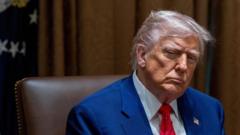Following a tumultuous week, the question remains: Is President Donald Trump any nearer to achieving his ambitious trade objectives? Last week, Trump unveiled a significant tariff plan that threatened to shift the global economic landscape and reconfigure longstanding trading relationships, especially with U.S. allies. However, a notable part of this initiative has been put on hold, as the President opted to delay higher tariffs on many nations for 90 days while intensifying economic confrontations with China. This leaves us to examine five of Trump's central trade aspirations and their current status.
1) **Better Trade Deals**
Trump declared: "For decades, our country has been looted, pillaged, and plundered by nations near and far..." His aggressive tariff approach initially sparked global concern, setting off a chain reaction among allied and rival nations alike. While administration officials tout over 75 world leaders reaching out to Trump for potential agreements, specific negotiations with countries including South Korea and Japan are now in progress. With the 90-day clock ticking, time will reveal whether these discussions yield fruitful outcomes.
2) **Boosting American Industry**
Trump asserted: "Jobs and factories will come roaring back into our country..." He has long viewed tariffs as a mechanism to enhance U.S. manufacturing by insulating it from foreign competition. Yet, the unpredictable nature of recent tariff changes creates hesitance among business leaders to make substantial investments in reshoring operations. Until there's more clarity on tariff levels and protections for various industries, companies may choose to adopt a wait-and-see approach.
3) **Facing Off with China**
Trump stated: "I have great respect for President Xi of China, but they were taking tremendous advantage of us." Although recent tariff developments have sparked a renewed focus on China as the principal trade issue, the dialogue now seems fraught with risks. This escalation could alienate vital allies and strain both economies. As Trump hints at a potential exit strategy, the long-term consequences for U.S.-China relations remain uncertain.
4) **Raising Revenue**
Trump claimed: "Now it's our turn to prosper..." He consistently promotes tariffs as a means to generate substantial revenue for reducing the national debt and funding tax initiatives. An analysis from the Tax Foundation estimates that a 10% universal tariff could yield $2 trillion over a decade. However, capturing this revenue hinges on maintaining tariff levels; any shift toward domestic production could diminish this income stream.
5) **Lowering Prices for Consumers**
Trump proclaimed: "Ultimately, more production at home will mean stronger competition..." Initial energy price dips may reflect market concerns over potential trade-induced recessions. Nevertheless, economic experts warn that implementing new tariffs could lead to increased costs for consumers, with lower-income families facing the brunt of the impact. The prospective price hikes challenge Trump’s narrative of an economic renaissance and could have significant ramifications for his administration's political capital.
As the landscape of Trump's trade initiatives unfolds, the implications for global trade, economic health, and U.S. standing in the international arena are becoming clearer. The intersection of these efforts presents a multifaceted challenge as various stakeholders await the President's next move.





















